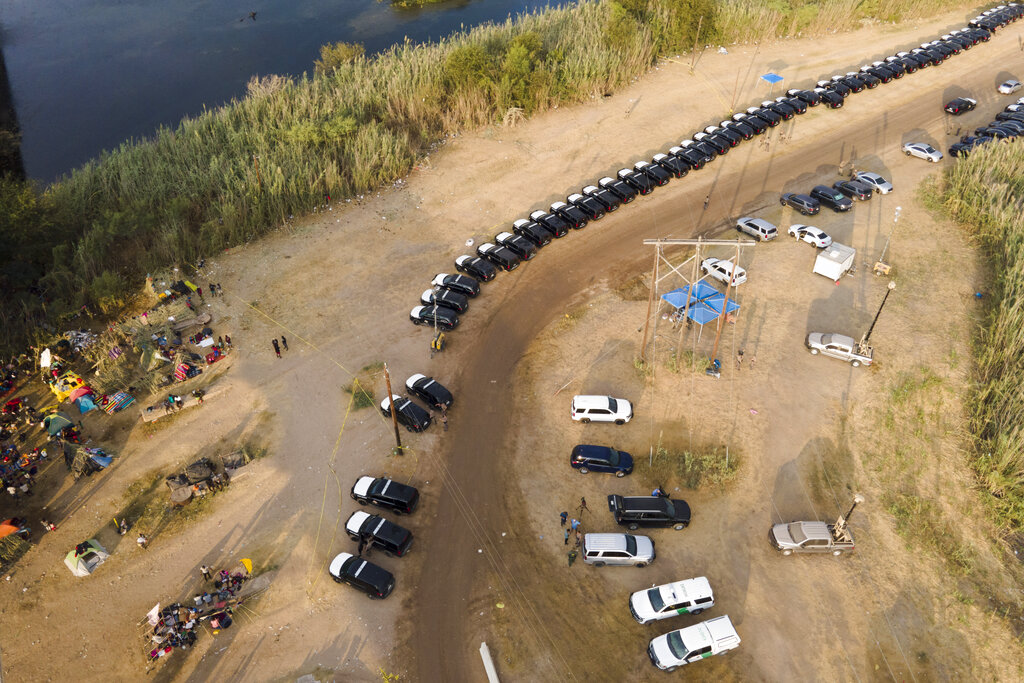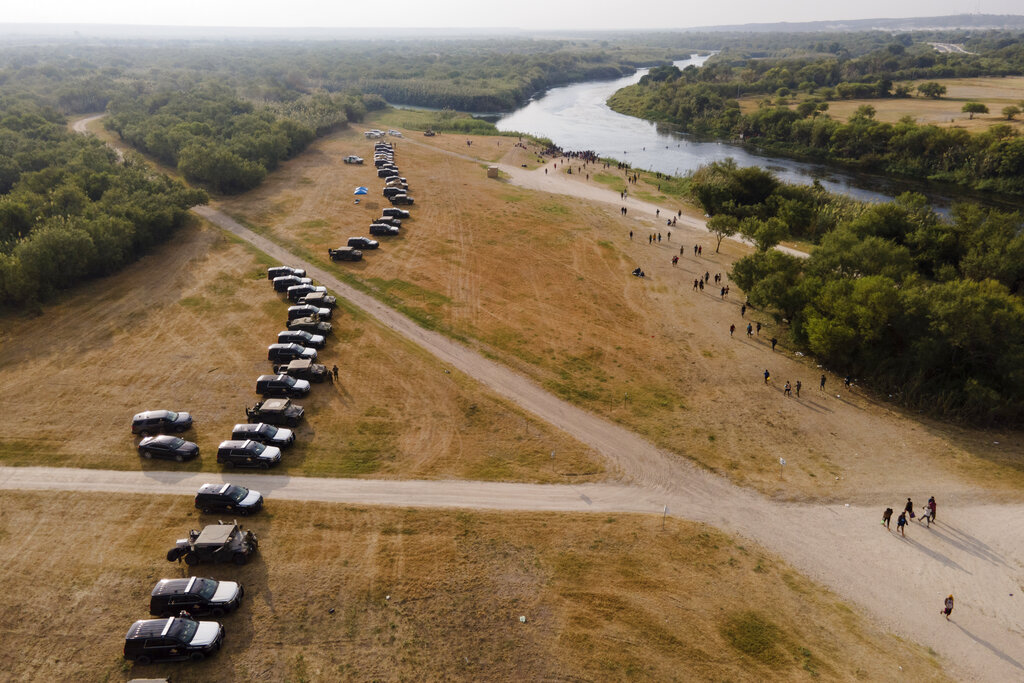By JUAN A. LOZANO, ERIC GAY, ELLIOT SPAGAT and MARIA VERZA Associated Press
DEL RIO, Texas (AP) — Options narrowed Tuesday for thousands of Haitian migrants straddling the Mexico-Texas border as the United States government ramped up expulsion flights to Haiti, and Mexico began flying and busing some away from the border.
More than 6,000 Haitians and other migrants had been removed from an encampment at Del Rio, Texas, U.S. officials said Monday as they defended a strong response that included immediately expelling migrants to their impoverished Caribbean country and faced criticism for using horse patrols to stop them from entering the town.
That was enough for some Haitian migrants to return to Mexico, while others struggled to decide on which side of the border to take their chances.
Jean Claudio Charles, 34, his wife and their 1-year-old son were stretching at dawn on Tuesday after sleeping on cardboard in a park by the river with 300 others who chose to return to Mexico from the U.S. side, some for fear of being deported and others because of a lack of food.
Charles said he did not want to leave the area, which is gradually becoming a new camp on the Mexican side, for fear of arrests.
“They are grabbing people, they bother us, especially Haitians because they identify us by skin,” he said.
But thousands of people remain at the camp in Texas. Republican Texas Gov. Greg Abbott, during a visit to Del Rio on Tuesday, said the county’s top official told him the most recent tally was about 8,600 migrants who remain there. He continued to slam the Biden administration and expressed skepticism the area would be cleared soon.
“They have shown no capability of being able to process all of these migrants by the end of the week,” Abbott said. “The only thing they have shown is an incapability of dealing with this crisis, candidly in a way where they pretend it doesn’t even exist. We’re here to tell you, it exists, it’s total chaos, and the Biden administration, they need to up their game big time.”
About six dozen officers with the U.S. Bureau of Prisons were in place Tuesday near Del Rio, according to three people familiar with the matter. The officers are mainly assisting U.S. Customs and Border Protection with transporting the migrants on Bureau of Prisons buses between detention facilities and from the Del Rio bridge, the people said. The people could not discuss the matter publicly and spoke to the AP on condition of anonymity.

On Monday, U.S. Department of Homeland Security Secretary Alejandro Mayorkas conceded it was a “challenging and heartbreaking situation,” but he issued a stark warning: “If you come to the United States illegally, you will be returned. Your journey will not succeed, and you will be endangering your life and your family’s life.”
Mexico’s Foreign Relations Secretary, Marcelo Ebrard, said Tuesday he had spoken with his U.S. counterpart, Secretary of State Antony Blinken, about the Haitians’ situation. Ebrard said most of the Haitians already had refugee status in Chile or Brazil and most weren’t seeking it in Mexico.
“What they are asking for is to be allowed to pass freely through Mexico to the United States,” Ebrard said.
Mexico has also begun flying and busing migrants from Ciudad Acuña to southern Mexico to relieve pressure on that stretch of border, according to two Mexican federal officials who requested anonymity because they were not authorized to speak publicly.
One of the officials said three busloads of migrants left Acuña on Tuesday morning for Piedras Negras, about 55 miles (90 kilometers) down the border, where they boarded a flight to the southern city of Villahermosa in the state of Tabasco.
The other official said there was a flight Monday from the northern city of Monterrey to the southern city of Tapachula near the Guatemala border. Tapachula is home to the largest immigrant detention center in Latin America. The flight carried about 100 migrants who had been picked up around the bus station in Monterrey, a hub for various routes north to the U.S. border.
The second official said the plan was to move to Tapachula all Haitians who had already solicited asylum in Mexico, since Tapachula is where most of them would have applied and they can only legally remain in Mexico while their case is processed if they stay in the south.
The Haitian migrants who are already in Mexico’s detention centers and have not requested asylum will be the first to be flown directly to Haiti once Mexico begins those flights, according to the official.
Meanwhile, Mayorkas and U.S. Border Patrol Chief Raul Ortiz said Monday they would look into agents on horseback using what appeared to be whips and their horses to push back migrants at the river between Acuña and Del Rio, a city of about 35,000 people roughly 145 miles west of San Antonio where thousands of migrants remain camped around a bridge.
Later Monday, the Department of Homeland Security issued a statement calling the footage “extremely troubling” and promising a full investigation that would “define the appropriate disciplinary actions to be taken.”
Mayorkas said 600 Homeland Security employees, including from the Coast Guard, have been brought to Del Rio. He said he has asked the Defense Department for help in what may be one of the swiftest, large-scale expulsions of migrants and refugees from the United States in decades.
He also said the U.S. would increase the pace and capacity of flights to Haiti and other countries in the hemisphere. The number of migrants at the bridge peaked at 14,872 on Saturday, said Brandon Judd, president of the National Border Patrol Council, a labor union that represents agents.
The rapid expulsions were made possible by a pandemic-related authority adopted by former President Donald Trump in March 2020 that allows for migrants to be immediately removed from the country without an opportunity to seek asylum. President Joe Biden exempted unaccompanied children from the order but let the rest stand.
Any Haitians not expelled are subject to immigration laws, which include rights to seek asylum and other forms of humanitarian protection. Families are quickly released in the U.S. because the government cannot generally hold children.

Haitians have been migrating to the U.S. in large numbers from South America for several years, many having left their Caribbean nation after a devastating 2010 earthquake. After jobs dried up from the 2016 Summer Olympics in Rio de Janeiro, many made the dangerous trek by foot, bus and car to the U.S. border, including through the infamous Darien Gap, a Panamanian jungle.
Some of the migrants at the Del Rio camp said the recent devastating earthquake in Haiti and the assassination of President Jovenel Moïse make them afraid to return to a country that seems more unstable than when they left.
“It’s not right,” said Haitian migrant Jean Philipe Samus. “The Americans are grabbing Haitians and deporting everyone to Haiti. Haiti has no president, no jobs, there is nothing. In the earthquake a lot of people died. It’s not right over there, I’m going back to Mexico.”
But Mayorkas defended his recent decision to grant Haitians temporary legal status due to political and civil strife in their homeland if they were in the United States on July 29, but not to those being sent back now.
“We made an assessment based on the country conditions… that Haiti could in fact receive individuals safely,” he said.




